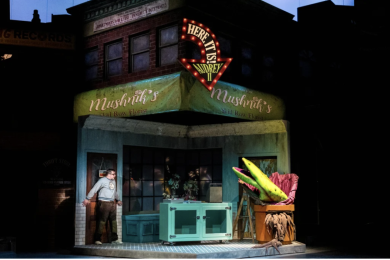Last week was a tough one at Playlist. While I struggled hard with
a play that felt maddeningly disconnected to the current political moment,
Dominic critiqued naturalistic theater for showing us too much of what we already know. After reading and re-reading both of our articles, along with
Ira’s assessment of
The Cocktail Hour as inessential the week before, I feared that we had all trapped ourselves in a critical box that we wouldn’t be able to argue our way out of. I wondered if we had bound ourselves too tightly to a theatrical ideal of both immediacy and transcendence, with both contemporary relevance and a sense of heightened theatricality.
On top of these critical concerns going into Genevieve Bennett’s production of
The Cherry Orchard, I have to admit that I generally approach Chekhov with a deep sense of dread. His characters all seem to be psychologically, financially, or physically stuck, so bad performances of Chekhov make me desperately aware of being trapped in a theater for two and a half hours of stasis (or, even worse, a hysterical nostalgia for a different life).
And then the play started. Bennett calls this a workshop, but she is being modest. This is flat-out some of the best ensemble acting I have seen in a long time. Rather than feeling trapped in my seat, I felt the motion and the frustrated desires of characters whose struggles were often communicated better in gestures than in words. Aside from being a joy to watch, these actors provide a clear argument in favor of naturalism – at least, naturalism done right.
Dominic accurately described naturalism last week with the adage, “character creates plot,” and for him, this often leads to over-determined productions that are so easily recognizable that they lead to easy conclusions. As for me, I have always found it easiest to think of naturalism as a chemistry experiment: take each character’s psychology and family history, shake them all up in a test tube, and see what happens. Naturalist authors of the late 19th and early 20th centuries were deeply influenced by Darwin and saw their work as a kind of literary science, which might contribute to the sense that naturalist writing can lack passion or surprise. And Chekhov’s writing, which can tend to explain the characters away with clunky bits of expository dialogue, does not always help his case.
Delightfully elusive
But with acting like this, Chekhov is neither dry nor over-determined. Through a long-term development process, the cast has created rich internal lives for each character. There was something elusive in each performance that made me want to call the characters back on stage and force them to explain themselves. Paul de Cordova’s portrayal of Yermolái Lopákhin’s entrepreneurial energy masks great destructive potential under a guise of affability that deceives even Lopakhin himself, while as Várya, Emily Gunyou Halaas submerges her loneliness under the effective management of the household. Separately, they conjure a powerful sense of emotional magnetism; together, they turn a comically awkward love scene into the play’s most devastating and unresolved moment.
But as frustrated as we might be when watching so many desires never come to fruition, this is how people really are: mysterious, sometimes illogical, and often unwilling or unable to provide closure. Genevieve Bennett seems to acknowledge that it is more satisfying to leave questions unanswered than to wrap them up neatly. I would venture to say that with all their little mysteries, these characters are more realistic than “realism.”
It is unexpectedly helpful that the play is being done in the Playwrights’ Center with nothing but chairs as a set. Although the characters are dressed in vaguely period costumes, there is nothing in the production that forces an interpretation based on time or place. Without a visual point of reference, we can focus on what is really going on in the play, in which economics and memory are intricately bound together as both catalysts and inhibitors of the action. This symbolic conflict is evident in the cherry orchard itself: when the play opens, the Ranyévskaya family estate has been foreclosed on and is threatened by an impending auction, while the white blossoms on the trees are a nostalgic reminder of family history and lost innocence.
Gentle symbolism
But as I said, the audience never sees this orchard. This is a good thing, because to focus too intently on the play’s symbolic structure would be to wedge it into an uncomfortably narrow box. Chekhov is much less concerned with symbolism than with real material factors, like how Liubóv’s poor financial choices have brought her family to ruin, or how the end of serfdom has affected the current residents of the area.
And as you might expect, economic circumstances are intricately linked to the characters’ psychological and emotional lives. Liúbov is unable to make a wise decision about her estate because she is paralyzed by her past, while Yermolái Lopákhin, who wants to buy the property, is so focused on his financial future that he is blind to Várya’s silent hope for a proposal. At the same time, everyone is willfully ignoring Firs, the aging butler (in an amazing transformation by Terry Hempleman), who reminds them all that the entire estate was essentially built on slave labor.
Walking into the Playwrights’ Center, I was worried that Chekhov would be stodgy, obvious, or disconnected from contemporary issues. But although naturalism mirrors life, it can also mirror life’s transcendent moments, and while art is always political, it does not need to be contemporary to be relevant. There’s a reason the classics are classic, and “workshop” though it may be, this production is the proof.





